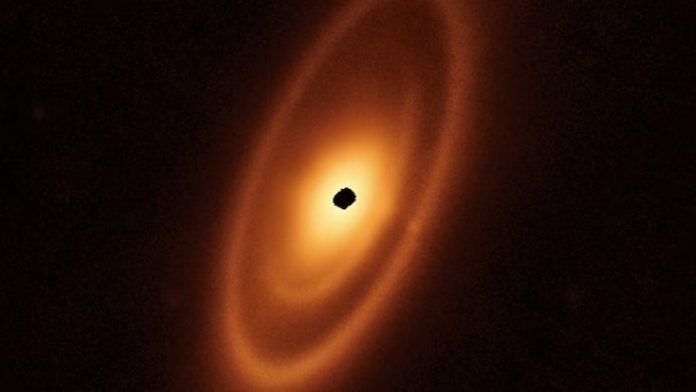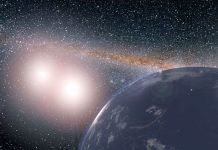
Astronomers have discovered a complex asteroid belt around a young star called Fomalhaut, using NASA’s James Webb Space Telescope.
The debris belts, which are the remnants of collisions between larger bodies, are the first asteroid belt ever seen outside of our solar system in infrared light.
They are described as ‘debris disks’, similar to the asteroid and Kuiper dust belts in our own solar system.
Nested belts with a unique structure
The astronomers found three nested belts around the star, with the outermost belt extending out to 14 billion miles (23 billion kilometers) from the star, which is 150 times the distance of Earth from the Sun.
The scale of the outermost belt is rough twice the scale of our solar system’s Kuiper Belt of small bodies and cold dust beyond Neptune.
The inner belts were revealed by Webb for the first time and are much more complex than those in our solar system.
Possible planetary system
The dusty belts around Fomalhaut are the debris from collisions of larger bodies, analogous to asteroids and comets, and are frequently described as ‘debris disks.’
These disks may indicate the presence of a planetary system. The belts most likely are carved by the gravitational forces produced by unseen planets.
Similarly, inside our solar system, Jupiter corrals the asteroid belt, the inner edge of the Kuiper Belt is sculpted by Neptune, and the outer edge could be shepherded by as-yet-unseen bodies beyond it.
Webb’s discovery
Webb’s Mid-Infrared Instrument (MIRI) imaged Fomalhaut’s dusty debris disk and revealed the three nested belts extending out to 14 billion miles from the star.
The inner belts – which had never been seen before – were revealed by Webb for the first time.
Webb is also enabling scientists to image a dozen or so asteroid belts elsewhere, helping them learn more about the inner warm regions of these disks.
Mystery and excitement
The belts around Fomalhaut are a mystery because no planets have been detected so far, but the complex structure of the belts is exciting because it indicates that there could be an embedded planet shaping the rings.
Astronomers have also imaged a great dust cloud, which may be evidence of a collision occurring in the outer ring between two protoplanetary bodies.
Theoretical basis
The idea of a protoplanetary disk around a star dates back to the late 1700s when astronomers Immanuel Kant and Pierre-Simon Laplace independently developed the theory that the Sun and planets formed from a rotating gas cloud that collapsed and flattened due to gravity.
Debris disks develop later, following the formation of planets and the dispersal of the primordial gas in the systems.
Conclusion
Astronomers have discovered a complex asteroid belt around a young star called Fomalhaut, using NASA’s James Webb Space Telescope.
The belts, which are the first asteroid belt ever seen outside of our solar system in infrared light, are the remnants of collisions between larger bodies and are frequently described as ‘debris disks’.
The complex structure of the belts is exciting because it suggests that there could be an embedded planet shaping the rings.
The astronomers believe that their discovery may help to provide insights into how exoplanetary systems form and evolve.
The study was published in the journal Nature Astronomy.
Copyright © 2023 Knowridge Science Report. All rights reserved.



